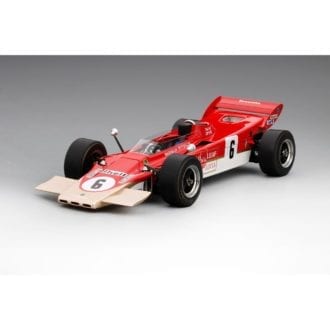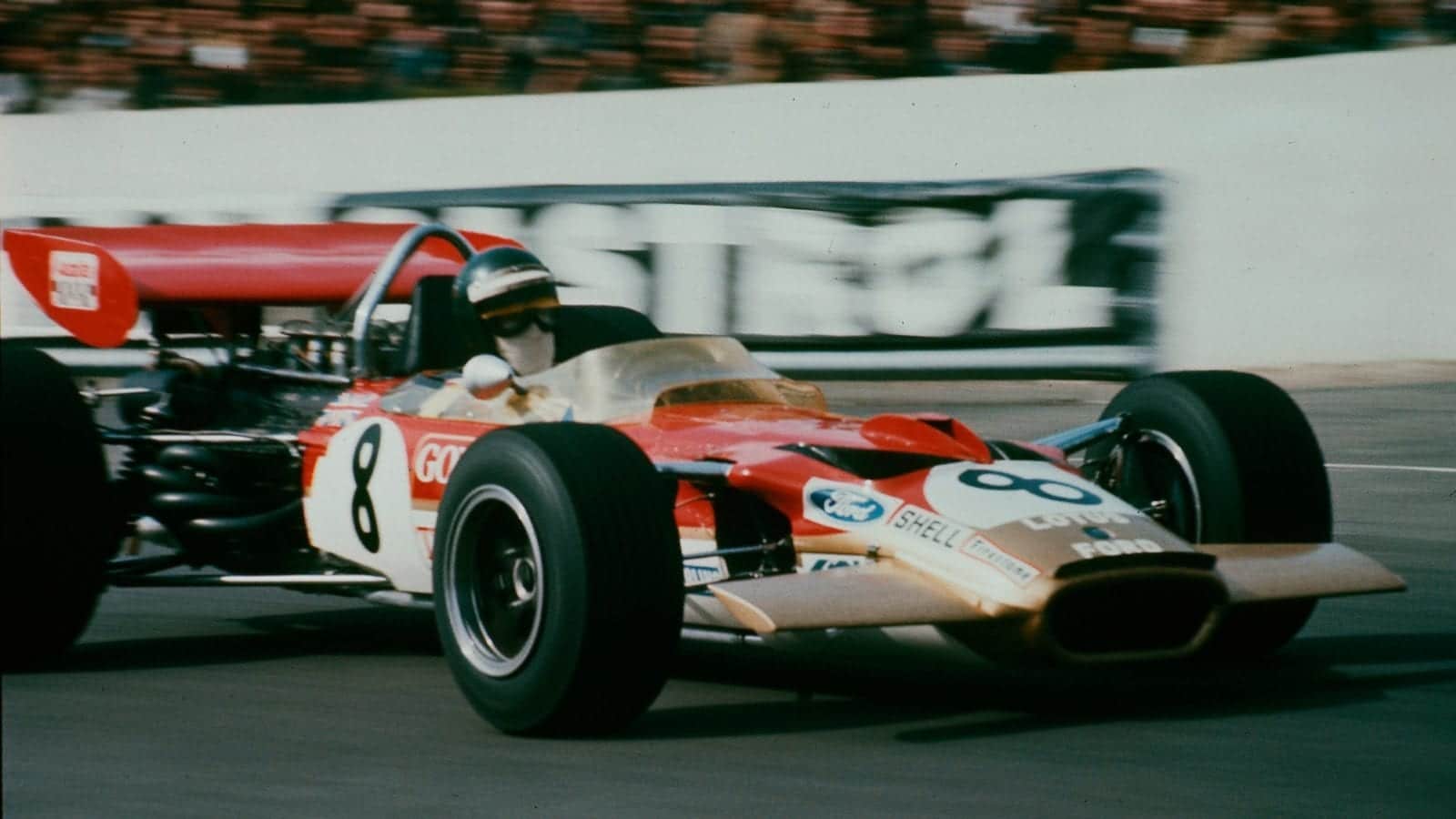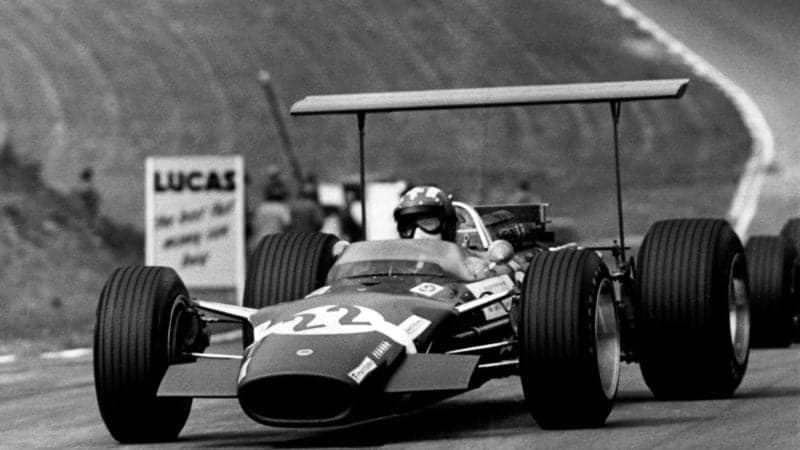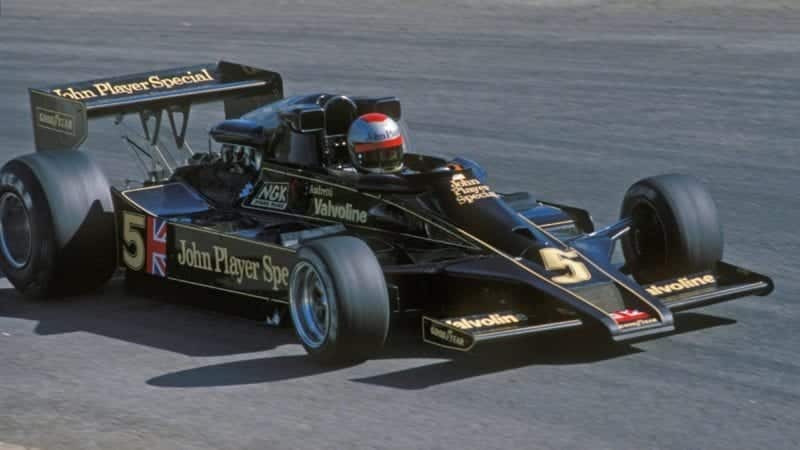
Lotus's Colin Chapman: 'You see? It designs itself...'
They were favourite words of Anthony Colin Bruce Chapman and showed just how easily car design came to him. Then again, explains Gordon Cruickshank, the man was a bona fide genius

No story on Colin Chapman could omit the word ‘innovation’. But his remarkable talent lay not so much in inventing devices as solving problems, and, more crucially, in identifying that problem first. What set him apart was his ability to look at the whole picture, ignoring the constraints of accepted knowledge while looking for a way to reduce weight, drag or complexity. If nothing existed to suit, he was too practical to set it aside and wait for technology to catch up; he would dismantle the problem and find answers to each of its constituent parts.
Often the latest clever idea became blindingly obvious — but it took Chapman to see it first. Hugh Haskell, a Lotus engineer in the Sixties, relates in his book Colin Chapman — Lotus Engineering how Chapman would guide a junior through the needs and constraints of the current problem until his pupil reached the key to it. Then he’d say “you see, it designs itself!” and walk away.
Although he took an engineering degree, his speciality was structural, not mechanical, engineering and this may well have helped his unusual ability to see the wide view. Structural engineering is yet more concerned than mechanical with economy of materials. A long-span beam, for example, has to cope with its own weight as well as applied loads. As you approach strength/span limits, the returns diminish: the thicker you make it, the less its strength increases. Generally this factor is less critical in automotive applications, but it is a crucial discipline for the structural engineer.
There are no long spans in a car, but Chapman’s perennial drive for fineness and lightness surely reflects this early indoctrination, and it is possible to surmise his ability to look laterally at problems also thrived in this field. Instead of focussing purely on designing a strong bridge, for example, the civil engineer might also consider a causeway. Chapman’s genius was that he could stand still further back and ask “do we need to cross the river at all?”
His first car, a trials special built in 1948 from an Austin Seven, addressed the notorious whippiness of the A7 chassis by using plywood side panels bonded to alloy sheet — extra rigidity for no extra weight, by stressing panels which would otherwise do no more than keep the wind out. At a time when the vintage idea of keeping the chassis flexible still existed, he identified that predictable handling required a stiff frame with pliant suspension.
By the time he began his Lotus MkII, Chapman had researched every A7 part and selected the best, collectively extracting more than anyone from more or less standard parts. The car proved a successful all-rounder in trials, sprints and rallies and, in 1950, brought Chapman his first track win. From then on racing became his focus, and he designed Lotus MkIII carefully around 750MC regulations. Not specifically ‘within’ those regulations: forced to retain the A7 chassis, he bolted tubular bracing to it — not the last twin chassis of his career. Similarly, he side-stepped the drawback of its siamesed intake ports by devising an inlet manifold with a divider which poked tongue-like into the port, effectively splitting it. His car ran rings around the opposition, and the inlet was banned the next year. Lateral thinking, clever solution from existing technology, regulations exploited but not broken, official disapproval — he was setting his pattern.
The MkIII’s achievements brought a couple of commissions to build cars, and allowed Chapman to work on his first chassis design. To finance a car for himself, he had to sell a run of this new MkVI, and again he stretched the rules, avoiding Purchase Tax by offering a kit for self-assembly. Though using off-the-shelf parts for cheapness, Chapman’s machine was a serious competition car featuring a triangulated tubular frame at a time when even Grand Prix cars had ladder chassis. It also had adjustable suspension, a key to his mastery of making optimum use of tyres.
The MkVI was the right car at the right time, and continuous demand, plus the race successes of its buyers, made Chapman a manufacturer. But it was racing which fired him, and allowed him to measure his achievements directly against others working under the same constraints. He loved to make parts redundant: using a fixed-length drive-shaft as the upper suspension link, putting fluids through chassis tubes, using a moulded tongue on the Elan bonnet to obviate hinges, and throwing away several feet of metal on the Lotus 49 by using the Cosworth DFV engine as the rear of the chassis and bolting the suspension to it.

Jo Siffert in the high-winged Lotus 49
Bernard Cahier/Getty Images
Very early on he focussed on airflow, loving the fact that lowering drag is a something for nothing deal. With smooth bodies designed by Frank Costin, the VIII, IX and Eleven (Chapman now dropped the roman numerals) sportscars looked like nothing else, and offered 130mph on only 80bhp. There were no exotic elements: they kept the split-beam front suspension of the VI, had unsophisticated running-gear and no costly lightweight materials. Yet they were light, simply because Chapman had distributed the minimum material efficiently, into a rigid tubular frame. At this time he was the only designer to have shown a knowledge of pure three-dimensional structures, and it led to his being asked to take a look at the Vanwall Grand Prix car. His advice on a space-frame chassis, a de Dion axle, and employing Frank Costin to shape the body turned Vanwall into Formula One winners — before he had even built his first single-seater.
Not all his ideas worked. His sequential ‘queerbox’ closed up all the gears in the ‘box by removing the selectors from in between them, and engaged gears by pins projecting from the hollow shaft. To this day it remains a fine concept, but no-one has yet made it work effectively.
Equally, what seemed the brilliant stroke of using the antiroll bar to locate the Eleven’s wheel upright, and making a suspension arm redundant, brought adjustment difficulties, so for his first rear-engined design, the 18, Chapman adopted simple double wishbones. Slightly heavier, but easier to setup, and therefore a net improvement. He was not one to cling too long to a principle: if the perfect part was hard to manufacture or repair, and the advantage it offered small, he was quite happy to abandon it for something plainer if it meant an overall benefit.
This was the opposite position to BRM, who tended to pursue an idea beyond the sensible cutoff point, and spend thousands on the best possible quality even when it wasn’t making the car faster. But after seeing what this ‘new boy’ had done for Vanwall, BRM also asked his advice, and allowed Chapman to change entirely the car’s suspension, transforming its handling. It was all good PR for the arrival of the Lotus type 12, the Formula 2 car which, in 1956, began the long train of Lotus single-seaters.
Though Chapman did not immediately follow the Cooper rear-engined route, he quickly became the one the others followed. The pencil-slim 20’s cigarshape became the single-seater racing norm until 1968 when the radiatorless Lotus 56 Indianapolis turbine car introduced the wedge profile and shovel nose, trying to burrow under the airstream. The most admired of this series, the 72, is remembered for what Rindt, Peterson and Fittipaldi did with it, but Kenneth Sears, now Head of Technical Strategy and Research at Lotus, thinks its real importance was in its layout. It was, he says, the car which established the ‘architecture’ of all F1 cars from then till now. Side radiators, fuel behind the driver, a nose which has only aerodynamic functions; not a fashion, but a logical optimum which still applies.
Though racing had first priority, it had to be supported by a turnover of road cars, and while the VI and the following VII appealed to the hardened enthusiasts and many weekend racers, Chapman’s next concept took Lotus in a direction, which has continued ever since glass-fibre. He wanted to build a comfortable road car; but instead of investing in heavy presses, or being restricted by individual hand-building, he ignored the norms of the time, read everything written about the subject (always a Chapman feature) and simply struck out fearlessly on his own.

As always he exploited the material to its limits, realising that since it was easy to make complex shapes, he could make one major moulding which did several jobs. Thus the 1957 Elite boasted the first glass-fibre monocoque shell, and confounded sceptics by boasting superb rigidity and delightful handling. It had suspension derived from the race cars, with the tall Chapman strut placed behind the seats, and front wishbones of wide-based shape to reduce the point loadings on the shell like an egg, a pure monocoque has a thin skin which needs reinforcing to cope with local pressure. But it was expensive and troublesome to build, it did not change the industry.
Having proved his technological point, Chapman remained quite open-minded when designing the Elan which followed. Unlike the Elite, the Elan was intended to be an open car, and the lack of roof makes it far harder to retain rigidity. But when Chapman saw the simple folded steel backbone his engineers had contrived to test the running gear without the body, he had no hesitation in adapting the idea for production. Bolted to the grp ‘tub’, it produced a stiff, and watertight, structure with what was effectively one huge reinforcing plate to cope with all the point-loads.
It worked well for the small-engined Elan, but in the constant cross-feed of ideas from the road to the racing side, it proved not to be so appropriate elsewhere. In the rear-engined 30 sportscar of 1964, Chapman reversed the frame, putting the Ford V8 of the Type 34 Indy racer in the fork and using the hollow spine for fuel. It was sensationally low and beautiful (another of Chapman’s assets was his eye for an elegant shape), but under the V8’s torque it flexed dreadfully. They never made it work properly. Though the Elite had successfully demonstrated the monocoque principle,
Chapman’s racers did not follow until 1962. From the elegant 16, last of the front engines, low drag came first and after the chunky 18 their shapes were pared down and down, with the driver lying clown flatter each time. With the 20, the bottom of the driver’s seat was as low as it could go; yet for the 22 Chapman sank the driver a little more by using his “Theory of the Compressibility of Bums” and slicing the seatbase off flat. However, as the chassis became slimmer, they lost the third dimension of height which brought rigidity. The answer came in 1962 with the 25, whose folded steel monocoque was a simpler but stiffer structure than a multi-tube. The new `tub’ was effectively a single structural member with the driver inside, made practicable by the availability of aircraft bag tanks for fuel which could be inserted within the hollow sections. Chapman’s eye always roved over other technologies for useful advances.
The 25 also marked the end of one innovation and the arrival of another. Chapman’s ‘wobbly web’ cast wheel had cleverly used a folded shape to make a rigid unit in the same way as paper becomes strong when corrugated. But as tyre widths soared, cast spokes became more efficient, and the 25 was the last Lotus to use them. Also, as the driver became more reclined, the windscreen became more of an obstruction. Chapman devised the venturi screen, where air was squeezed up through a slot to form an air-curtain — the same principle as on Renault’s recent Spider. He even used ‘structural air’ in 1958, when Le Mans regulations banned rigid tonneau covers; his cars had a cover like an inflatable cushion. Almost as good as metal, and quite legal…
Chapman knew from the start that drag was power thrown away, and even the VIII and IX had carefully crafted aerodynamics inside the engine bay as well as underneath. Through the Sixties, racing car aerodynamics were all about air penetration, until Jim Hall equipped his Chaparral with its wing. After the banning of 1969’s high wings, which acted directly on the wheel uprights, designers seemed stuck with nose and tail wings to push the body down on its suspension, requiring very hard springs which not only battered the car but were also desperately uncomfortable for the driver. It took Chapman some time to figure out how to get that downforce off the suspension and on to the wheels again within the rules, but in 1981 he revealed his answer — the twin-chassis 88.
What the regulations said was that downforce had to be applied through the suspension. His approach effectively enlarged the old illegal high wings, joined them into one huge super-wing and dropped this down to bear on the suspension through light springs. Within this new structure, the traditional monocoque still rode on its own springs as if the outer shell were not there, the driver bobbing up and down slightly through the opening in the upper surface. Because the secondary springs were so light, they squashed flat with the downforce, applying it directly to the tyres. It was perfectly brilliant, and perfectly legal, but as we know it was ‘clarified’ by the rule-makers into the parc fermé of those ideas which would catapult one outfit into a clear lead.

The Lotus 78 experimented with side skirts to maintain ground effect
Grand Prix Photo
While brewing the twin-chassis idea, Chapman had filled in with his most far-reaching concept of recent years: it was first seen on the 1977 Lotus 78 wing-car, in which he turned much of the body into an upside-down aerofoil and then contrived the idea of side-skirts to stop the air flooding in from the sides and undoing much of the benefit. The subsequent ‘ground-effect’ era, though inspired by Chapman, was ironically a lean time for Team Lotus after the 79’s all conquering ’78 season. The 88 would have leap-frogged them back on form, and its banning affected Chapman greatly.
It was at this point that Chapman focussed on the design of a microlight aircraft. Having recently wound up his motor-cruiser companies (where he had achieved new levels of lightness for grp hull structures) the emerging microlight field seemed to offer design opportunities not much fettered by rules, unlike the way racing was going. Says Ken Sears, “He was always finding ways of winning through innovation, so when racing began to be tightened up to make a better spectacle, he lost the thrill of the big bold step. He’d probably be bored today, with small steady refinements”.
Typically, he assembled everything written on microlights and learned to fly one. As most microlights were tube and fabric affairs then, the rules were basic too. Chapman, a life-long aero-enthusiast and pilot, envisaged an enclosed and superlight composite two-seater, a practical tourer which would still qualify as a microlight something the authorities had not forseen. It would have significantly undercut the Cessna market. Tony Rudd designed an elegant little four-stroke engine, and the striking canard shape was developed by Rutan in the USA. The prototype was ready to fly on the day Chapman died in December 1982; like all the non-motoring projects, including the Lotus furniture designs, it was soon dropped.
From early days, of course, Chapman employed many designers to carry out his intentions, and the personal contributions of Mike Costin, Len Terry, Tony Rudd, Peter Wright and many others were all vital. But one of Chapman’s talents was extracting from others what he himself could envision, and his hand steered every project. Sears: “Chapman could set people targets beyond what they thought they could achieve. His whole approach was one of innovation and competition; winning races or being first to the airport, it mattered to be one up.”
The creative atmosphere has always pervaded Lotus, and still does. The Norfolk company is a world-leader in composite moulding and a pioneer of active suspension. Sears thinks that the latter was possibly the first major innovation suggested to, instead of by Chapman, and proved it was possible to separate and resolve factors such as response and travel previously thought incompatible. Similarly the Olympic medal-winning Lotus bicycle, which incorporates some ‘bad’ engineering (the single-sided fork) for aerodynamic gain. And while the Elise’s bonded aluminium chassis is rightly praised, it uses technologies which already existed. Someone just had to be bright enough to put them together in a new way — a lesson learned from the man who created Lotus.
